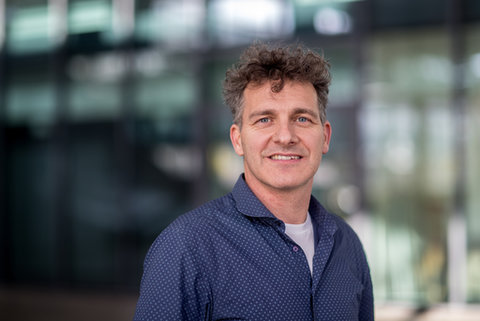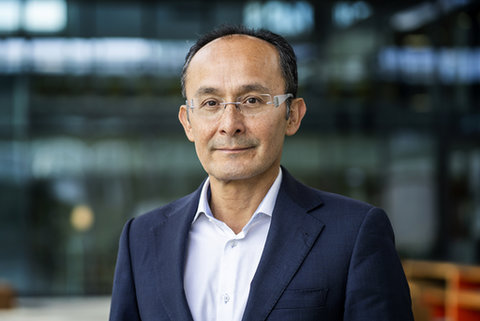9
Actively seeking synergies
The aim of the Eindhoven Hendrik Casimir Institute is to create a unique synergy between the world-class photonics and quantum research at TU/e. Three of the institute’s Principal Investigators share their personal views on how this combination will ultimately enable a sustainable information society, and how it already influences their own respective research fields.

Erik Bakkers
Erik Bakkers, Full Professor and head of the Advanced Nanomaterials & Devices group at the Department of Applied Physics and Science Education:
‘Our future communication and computing systems will rely on quantum based alternatives for the current electronic bits. To construct these so-called qubits, different possibilities are currently under investigation. For example, there are people working on atomic qubits based on ultracold Rydberg atoms. Other groups are for example looking at spin qubits in silicon.
But once you have these qubits, how do you make them work together? Photonics is the only viable solution there, since for electronics, the coherence lengths are way too short and the quantum information will get lost along the way. That is where my own research comes in. We try to merge photonics and quantum technology at the material level by changing material properties.
For example, we are adjusting silicon to make it emit light. We have already demonstrated hexagonal silicon-germanium nanowires with a bandgap. However, to actually use our material to photonically couple silicon spin qubits, we now need to transform our wires into 2D surfaces.
Another interesting synergetic endeavor would be to try and couple the cold atoms from the Coherence and Quantum Technology group to the integrated waveguides and optical components developed at the Photonic Integration group.
EHCI should stimulate such collaborations by physically bringing people together and supplying them with some seed funding to explore new joint directions. Our research in both fields is flourishing, with TU/e taking part in large scale programs like PhotonDelta and Quantum Delta. Now is the time to define a dot on the horizon that combines the best of both worlds.’

Chigo Okonkwo
Chigo Okonkwo, Associate Professor leading the high capacity optical transmission laboratory of the Electro-Optical Communications Group at the Department of Electrical Engineering:
‘My research is focused on maximizing the amount of data we can transmit through optical fibers, which form the backbone of the Internet. One of the challenges we face is to secure all of those data, not only now but also in the future when there will be quantum computers around.
At TU/e, we have all required expertise on board to build a quantum secure network, ranging from the integrated photonics technology required for the development of quantum secure receivers to the quantum cryptography software protocols. For example, in our QKD testbed, we are using quantum properties of photons to create cryptographic keys. The beauty of this approach is that it is impossible to eavesdrop without getting noticed, since any measurement on the quantum properties of the photon instantly changes them.
The ultimate dream is to generate super stable qubits and build a real quantum internet. To be able to achieve that, we need to expand on the existing expertise in the institute and bring all of it together.
For us to be successful, high quality research in each of the individual underlying technologies is the basis. As an institute, we should not exclude any topics upfront, but instead explore a variety of directions to identify the most promising routes. The institute should amplify the voices of the individual principal investigators embedded in the institute and connect them to people that can elevate them. Plus, to make an impact, we need to be sure to get an invite to the relevant table.’

Idelfonso Tafur Monroy
Idelfonso Tafur Monroy, Full Professor in the Electro-Optical Communication group at the Department of Electrical Engineering:
‘In my opinion, EHCI is a funnel, that connects a broad range of research at TU/e to a broad range of stakeholders in the outside world. We need to know what’s going on both internally and externally to capture the needs from the outside and connect them to the expertise here.
The combination of photonics and quantum technology discloses a huge potential for new businesses to emerge. But stakeholders need to experience for themselves what these technologies can bring. EHCI brings the right people together to realize concrete demonstrators like our quantum key distribution testbed. We need these types of demonstrators to not only further develop the technology, but to also make partners from industry aware of what’s coming.
At TU/e, we have plenty of technologies we could combine for new applications. We have people working on qubits, on high capacity optical networks, on photonic chips, on neuromorphic computing…
The institute can help connect all of these individual topics and researchers and look for possibilities to leverage on existing strengths. The challenge will be to both stay inclusive and at the same time define a focus for the institute, and to strike a balance between what is interesting now and what might become of importance later. I am convinced, that if we do this right, as a university we will truly impact the sensing, communication and computing paradigms for the future.’